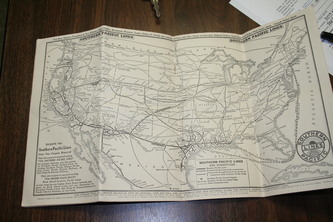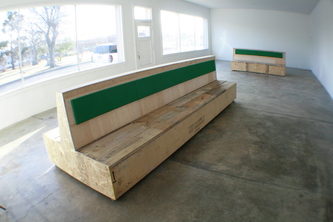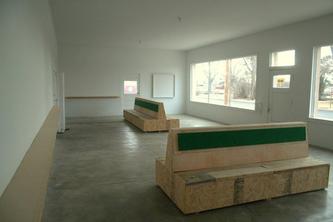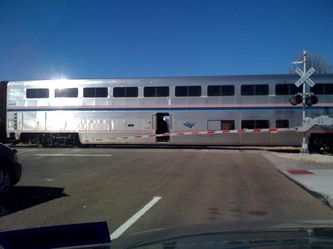| FOLKE KÖBBERLING |
|
Folke Köbberling & Martin Kaltwasser
next stop: Marfa 2010
Locker Plant, Chinati Foundation, Marfa/Texas (US)
next stop: Marfa 2010
Locker Plant, Chinati Foundation, Marfa/Texas (US)
Marfa ist ein Stadt im Süden des US-Bundesstaates Texas und Sitz der Countyverwaltung des Presidio Countys. Marfa hat 2121 EinwohnerInnen. Marfa liegt in der Nähe des Big-Bend-Nationalparks. Nachbargemeinden sind Alpine, Fort Davis, Valentine und Presidio. Marfa wurde 1883 als Wassertankstelle für die Southern Pacific Railroad-Strecke New Orleans-El Paso-Los Angeles gegründet und wuchs rasch bis 1920. Das Handbook of Texas berichtet, dass die Ehefrau eines Eisenbahningenieurs den Namen "Marfa" vorschlug, nachdem sie ihn in Fiodor Dostojewskis Roman Die Gebrüder Karamazow gelesen hatte. Marfa war jahrzehntelang ein wichtiger Bahnhof für Viehtransporte und bis 1945 zur Versorgung von lokalen Militärstützpunkten. Marfa entwickelte sich seit den 1970er Jahren zur Künstlerstadt, nachdem der US-amerikanische Bildhauer Donald Judd sich in Marfa niedergelassen und dadurch die Stadt bekannt gemacht hatte. In Marfa kreuzen sich der U.S. Highway 67 und der U.S. Highway 90. Marfa hat einen Verkehrsflughafen. Züge halten in Marfa schon lange nicht mehr. Im 24 Meilen entfernten Alpine hält alle 2 Tage der Amtrak-Zug "Sunset Limited", der New Orleans mit Los Angeles verbindet. Im Autoland USA erinnnert eine Reise im Zug an Eisenbahnfahrten in Europa zur Mitte des vergangenen Jahrhunderts. Die ist kein Zufall ist, denn in den 1950er Jahren wurde das U.S.-amerikanische Highwaysystem auf Druck der großen Autokonzerne zu Lasten des bis dahin perfekt funktionierenden Eisenbahnsystems mit allen Mitteln durchgesetzt und somit das Automobil zur U.S.-amerikanischen Hegemonialkultur gemacht.
Folke Köbberling und Martin Kaltwasser, derzeit Artists-in-Residence der Chinati-Foundation in Marfa, bauen die Galerie "Locker Plant" temporär in eine Bahnhofshalle um. Zum Umbau verwenden sie ausgemustertes Kistenmaterial aus den Beständen der Chinati Foundation das ursprünglich der Lagerung und Verschickung von Kunstwerken Donald Judds diente. Die Galerie liegt 25 Meter nördlich der Bahngleise. Die sie umgebende Stille wird alle zwei Tage vom durchfahrenden "Sunset Limited" mit dessen Schlaf- und Panoramawagen unterbrochen und mehrmals täglich von 800 Meter langen Viehtransportzügen, die ebenfalls durch Marfa durchrasen. Von der zur Bahnhofshalle umgebauten Galerie aus installieren die Künstler einen Steg bis zu den Bahngleisen. Das Künstlerpaar inszeniert eine Vision für ein U.S.-amerikanisches Mobilitätskonzept, das den Anachronismus der Automobilkultur abgelegt hat. Zu Beginn des 21. Jahrhundert könnte es aufgrund von Energieknappheit und der Rückbesinnung auf frühere, fortschrittlichere Verkehrsmittel als das Automobil zu einer Renaissance der Eisenbahnen kommen. So könnte Marfa, wie es dies auf anderen, kulturellen Gebieten schon tut, beispielgebend sein für eine konkrete Sichtbarmachung des Begriffes "Change". Köbberling und Kaltwasser zeigen, dass "Change" mit ein paar wenigen materiellen Mitteln in Form eines kleinen gebastelten Bahnhofs zu realisieren ist. Ein Bahnhof in Marfa: Ein kleiner Schritt für uns -- ein großer Schritt für die Menschheit.
Marfa is a city in the southwestern part of the US state of Texas and the seat of Presidio County. Marfa has approximately 2121 inhabitants.
The town is about an hour from Big Bend National Park; neighboring municipalities are Alpine, Fort Davis, Valentine and Presidio. Marfa was created in 1883 as a water-tank stopping-point for the Southern Pacific Railroad route New Orleans - El Paso -Los Angeles. The town grew rapidly into the 1920s. The Handbook of Texas reports that the wife of a railway director suggested the name "Marfa" after she read Fyodor Dostoyevsky's novel The Brothers Karamazov. Marfa was for many decades an important station for cattle transports and, until 1945, for the supply of local military bases. In the 1970s and '80s the American sculptor Donald Judd established private residences and a public museum in Marfa, and the town has since developed into a cultural destination. In Marfa US highways 67 and 90 cross. The town has an airport. Trains have not stopped in Marfa for a long time. Every other day the Amtrak train "Sunset Limited" stops in the town of Alpine (24 miles away from Marfa) and connects New Orleans with Los Angeles. In the contemporary car country of the US, a journey by train can bring to mind a railway trip of the middle of the past century. This is no coincidence, since in the 1950s the US Highway system was created as a result of extreme pressure exerted by large car companies such as GM. The new highway system downgraded the up-till-then perfectly functioning railway system. The car took over---seemingly everywhere.
Folke Köbberling and Martin Kaltwasser, current Artists in Residence at the Chinati Foundation in Marfa, have transformed the Locker Plant gallery in the center of Marfa into a temporary railway station. For their installation they have used old package and shipping materials used to transport and protect the sculptures of Donald Judd. The gallery is located 25 meters north of the rail tracks. The surrounding silence gets interrupted every second day by the "Sunset Limited " passing through town with its sleep and panorama cars and several times daily by 800-meter-long cattle transport trains. From the temporary concourse the artists have installed a path up to the rail tracks. With the exhibition the artist duo hopes to produce a vision for a U.S. mobility concept to replace the still existing but anachronistic automobile culture. At the beginning of the 21st Century, faced with rampant energy shortages, perhaps we can envision a renaissance of the railway system: the return of an earlier, more progressive form of public transport. Marfa, known already for its cultural areas, could show a concrete vision of the term "CHANGE ". Köbberling and Kaltwasser show that "CHANGE" can be realized with just a few humble materials in the form of a small handcrafted station.
A station in Marfa: A small step for us - a large step for mankind.
Kunstforum InternationalZur Bearbeitung hier klicken
Folke Köbberling und Martin Kaltwasser, derzeit Artists-in-Residence der Chinati-Foundation in Marfa, bauen die Galerie "Locker Plant" temporär in eine Bahnhofshalle um. Zum Umbau verwenden sie ausgemustertes Kistenmaterial aus den Beständen der Chinati Foundation das ursprünglich der Lagerung und Verschickung von Kunstwerken Donald Judds diente. Die Galerie liegt 25 Meter nördlich der Bahngleise. Die sie umgebende Stille wird alle zwei Tage vom durchfahrenden "Sunset Limited" mit dessen Schlaf- und Panoramawagen unterbrochen und mehrmals täglich von 800 Meter langen Viehtransportzügen, die ebenfalls durch Marfa durchrasen. Von der zur Bahnhofshalle umgebauten Galerie aus installieren die Künstler einen Steg bis zu den Bahngleisen. Das Künstlerpaar inszeniert eine Vision für ein U.S.-amerikanisches Mobilitätskonzept, das den Anachronismus der Automobilkultur abgelegt hat. Zu Beginn des 21. Jahrhundert könnte es aufgrund von Energieknappheit und der Rückbesinnung auf frühere, fortschrittlichere Verkehrsmittel als das Automobil zu einer Renaissance der Eisenbahnen kommen. So könnte Marfa, wie es dies auf anderen, kulturellen Gebieten schon tut, beispielgebend sein für eine konkrete Sichtbarmachung des Begriffes "Change". Köbberling und Kaltwasser zeigen, dass "Change" mit ein paar wenigen materiellen Mitteln in Form eines kleinen gebastelten Bahnhofs zu realisieren ist. Ein Bahnhof in Marfa: Ein kleiner Schritt für uns -- ein großer Schritt für die Menschheit.
Marfa is a city in the southwestern part of the US state of Texas and the seat of Presidio County. Marfa has approximately 2121 inhabitants.
The town is about an hour from Big Bend National Park; neighboring municipalities are Alpine, Fort Davis, Valentine and Presidio. Marfa was created in 1883 as a water-tank stopping-point for the Southern Pacific Railroad route New Orleans - El Paso -Los Angeles. The town grew rapidly into the 1920s. The Handbook of Texas reports that the wife of a railway director suggested the name "Marfa" after she read Fyodor Dostoyevsky's novel The Brothers Karamazov. Marfa was for many decades an important station for cattle transports and, until 1945, for the supply of local military bases. In the 1970s and '80s the American sculptor Donald Judd established private residences and a public museum in Marfa, and the town has since developed into a cultural destination. In Marfa US highways 67 and 90 cross. The town has an airport. Trains have not stopped in Marfa for a long time. Every other day the Amtrak train "Sunset Limited" stops in the town of Alpine (24 miles away from Marfa) and connects New Orleans with Los Angeles. In the contemporary car country of the US, a journey by train can bring to mind a railway trip of the middle of the past century. This is no coincidence, since in the 1950s the US Highway system was created as a result of extreme pressure exerted by large car companies such as GM. The new highway system downgraded the up-till-then perfectly functioning railway system. The car took over---seemingly everywhere.
Folke Köbberling and Martin Kaltwasser, current Artists in Residence at the Chinati Foundation in Marfa, have transformed the Locker Plant gallery in the center of Marfa into a temporary railway station. For their installation they have used old package and shipping materials used to transport and protect the sculptures of Donald Judd. The gallery is located 25 meters north of the rail tracks. The surrounding silence gets interrupted every second day by the "Sunset Limited " passing through town with its sleep and panorama cars and several times daily by 800-meter-long cattle transport trains. From the temporary concourse the artists have installed a path up to the rail tracks. With the exhibition the artist duo hopes to produce a vision for a U.S. mobility concept to replace the still existing but anachronistic automobile culture. At the beginning of the 21st Century, faced with rampant energy shortages, perhaps we can envision a renaissance of the railway system: the return of an earlier, more progressive form of public transport. Marfa, known already for its cultural areas, could show a concrete vision of the term "CHANGE ". Köbberling and Kaltwasser show that "CHANGE" can be realized with just a few humble materials in the form of a small handcrafted station.
A station in Marfa: A small step for us - a large step for mankind.
Kunstforum InternationalZur Bearbeitung hier klicken















